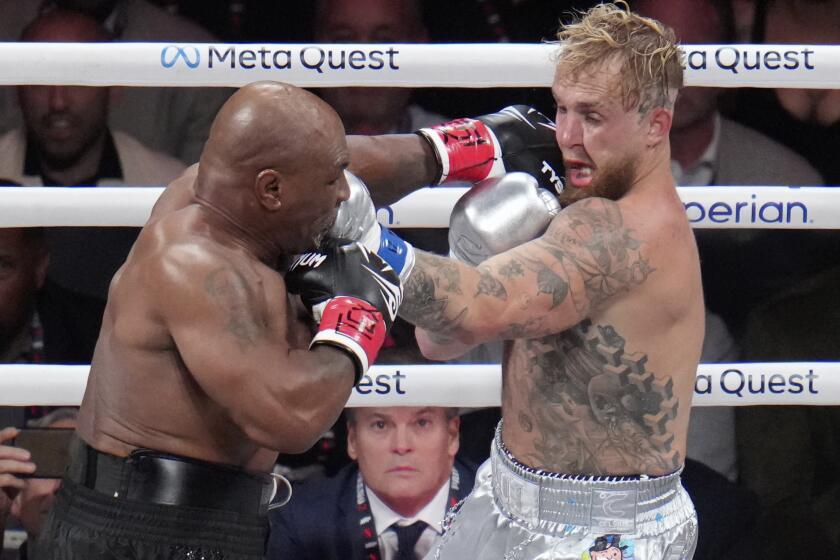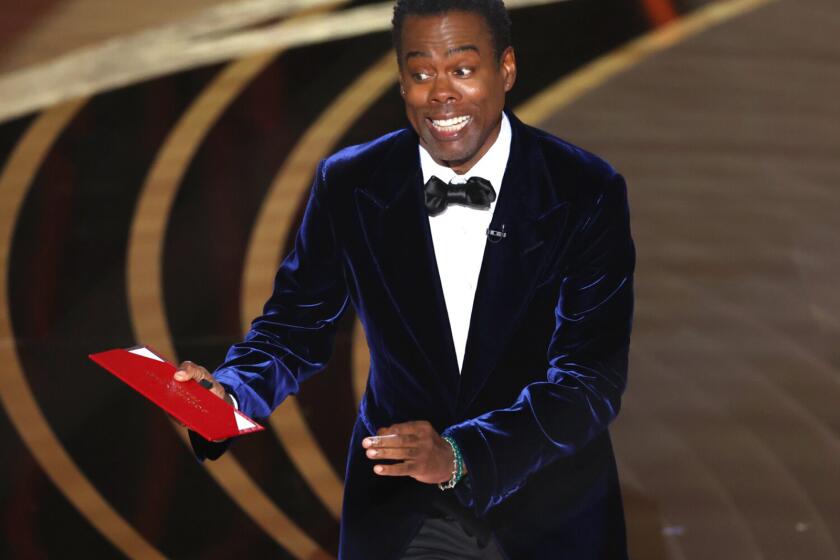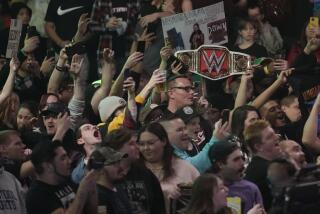Huge sports events are coming to streaming. Is the technology ready for prime time?

- Share via
The much-hyped Mike Tyson fight against YouTuber-turned-boxer Jake Paul showed the potential power of Netflix to create live, global sports events on streaming video. For many people though, it also demonstrated the limitations of the technology.
Thousands of Netflix users reported technical difficulties while trying to watch the fight. Frustrated viewers contended with buffering and blurry video, a result of tens of millions of households trying to watch the bout at once. It’s the kind of thing that, if the event were aired on a traditional network, would have provoked angry calls to cable companies.
Live sports is considered one of the great opportunities for streamers, including Netflix, which need mass audiences tuning in to please advertisers. Companies including Amazon and Apple are spending big, driving up the price of live sports rights and encroaching further on the turf of legacy network rivals.
But sports are also a challenge for tech firms. Even without buffering or grainy feeds, live streams are typically delayed compared with cable and satellite broadcasts, which means streaming audiences risk seeing spoilers on social media if the events are simulcast.
For Netflix, the stakes are high. The company will host its first live NFL games on Christmas Day, including one featuring a halftime show from Beyoncé. Netflix is also preparing to air WWE’s “Raw” pro-wrestling franchise starting next year.
Brandon Riegg, Netflix’s vice president of nonfiction series and sports, said he has “full faith” in the company’s engineering team, which learned much from the Paul vs. Tyson live match and will adjust before the NFL games. Netflix said it worked quickly to stabilize the viewing for a majority of its subscribers during the boxing event, in which the 27-year-old Paul defeated the 58-year-old Tyson.
“We were overwhelmed in the sense of the expectation — it far exceeded our expectations in terms of how many people came to the fight,” Riegg told The Times. “It’s as simple as that. As much as we forecast how many people would come, many, many more people came. It’s impossible for our engineering team to test that magnitude of traffic and viewership unless they have a real, live thing, which is what happened.”
On the bright side, Netflix showed that it can be a big draw for sports fans, with an average audience of 108 million live viewers globally tuning in for the fight. Netflix said there were 65 million live concurrent streams, calling it the “most-streamed global sporting event ever.”
Industry observers say the day is coming when streamers could place their own bid to host the Super Bowl on their platforms, as long as they can handle the traffic.
“Once they prove that they’re capable of delivering a consistent, robust, top-of-the-line, premium experience for these events that consumers have grown to expect, then I have no doubt that we’re going to get there,” said Rob Rosenberg, a former Showtime Networks executive and founder of New York-based Telluride Legal Strategies.
YouTube sensation-turned-boxer Jake Paul defeats the 58-year-old Mike Tyson in their heavyweight fight at AT&T Stadium in Arlington, Texas, on Friday night.
The technological challenges aren’t unique to Netflix. Glitches have arisen during other live events streamed on competitors’ platforms, including on YouTube during an NFL game last year and on Amazon’s Prime Video during a Thursday Night Football game in 2022.
Jake Paul’s unanimous-decision victory over Mike Tyson brought in a gate of more than $18 million, a record for a boxing or MMA bout held in the U.S. outside of Las Vegas.
There are various reasons why buffering occurs, particularly with a highly anticipated program.
When a sporting event is being live streamed, the captured video is released in smaller segments of a few seconds in length that are then transmitted to streaming subscribers and decoded by the users’ devices. If too many devices are seeking those video segments at the same time, it can cause a backlog. Streamers can try to solve the problem by rerouting traffic, but even that sometimes isn’t enough.
Streaming services can try to prepare ahead of time by buying more bandwidth capacity from the internet service providers, but it can be difficult to guess how many people will watch, especially if the streamer is new to a particular type of content.
There may be limits on how much bandwidth companies can buy. For example, Australia has much less available bandwidth compared with the United States, said Simon Wistow, a co-founder and vice president of strategic initiatives at cloud computing company Fastly.
Wistow added that if streamers buy too much capacity and it isn’t used, that’s wasted money.
“There’s a lot of complexities, a lot of things go on,” Wistow said. “The scale of internet traffic just gets bigger and bigger every year.”
Netflix said it will improve its systems to better handle live events at unprecedented scale and work with ISPs to continue increasing its capacity.
The company has been steadily putting on more live events, such as a hot dog eating competition, Screen Actors Guild Awards and a tennis exhibition match. The company’s first live event was a Chris Rock comedy special last year, which has drawn 23.5 million views. An early effort at live streaming, a “Love Is Blind” reunion special, encountered technical trouble due to a bug that went unnoticed until people tried to watch the program.
The Paul vs. Tyson event was a new milestone for Netflix’s live streaming efforts.
For some viewers, such as Florida resident Malcolm Scott, the streamer’s issues were unacceptable. Scott even sued Netflix for breach of contract last week, alleging that Netflix viewers missed large portions of the fight. Netflix declined to comment on the lawsuit.
Comedian Chris Rock will be the first artist to perform a live special on Netflix, which some analysts say could help create more appointment-based TV on streaming.
Brian Comiskey, a futurist at the trade group Consumer Technology Assn., chalked Netflix’s problems up to technological growing pains.
“At the end of the day this is content being delivered from thousands of miles away via files,” said Comiskey, calling himself a millennial who remembers what it was like before the smartphone. “This is a tremendous step in technology, but it only gets better from there.”
Brian Rolapp, the NFL’s chief media and business officer, said he believes Netflix will be ready to stream its games.
“I think it shows the power of their global platform, their international reach, which is one reason why we did this deal,” Rolapp said during the Sports Business Journal Media Innovators Conference. “So, I think what they did was pretty extraordinary.”
The Times’ Entertainment and Arts deputy editor Matt Brennan and news researcher Scott Wilson contributed to this report.
More to Read
Inside the business of entertainment
The Wide Shot brings you news, analysis and insights on everything from streaming wars to production — and what it all means for the future.
You may occasionally receive promotional content from the Los Angeles Times.














